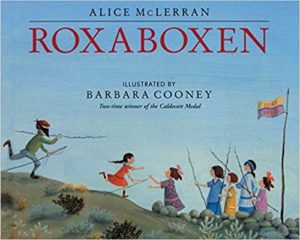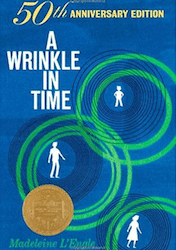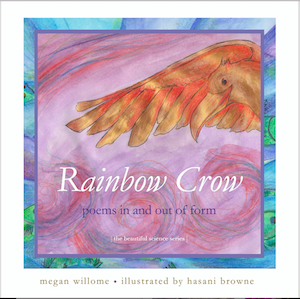“Marian called it Roxaboxen. (She always knew the name of everything.)”
That’s how this story by Alice McLerran, illustrated by Barbara Cooney, begins. We’re dropped on a hill with sand, rocks, boxes, cactus, greasewood, and “thorny ocotillo.”
In some ways this story is ubiquitous — kids play outside with only rocks, boxes, and their imaginations. They create a small city filled with the types of buildings and people that fill cities everywhere. Even though their clothes identify the time period as about 100 years ago, we know these children. We all know a Marian: “Marian was mayor, of course; that was just the way she was. Nobody minded.” We all know a Jamie, who likes to be the police. We probably know a quiet Anna May who cannot drive without speeding. We may know — we may be — a Frances, who builds herself a house outlined with jewel-colored desert glass.
But these children are not the first to play here: “Roxaboxen had always been there and must have belonged to others, long before.” Roxaboxen existed before these children, and it will exist after them. “Roxaboxen was always waiting,” we’re told. “Roxaboxen was always there.” On that same page, we’re told a second time, “Roxaboxen was always there.” The only thing that changes is the children.
On the second to last page we read, “The seasons changed, and the years went by,” and a page later, “The years went by, and the seasons changed.” When we’re young we notice the seasons, but the years seem forever long. As we age the years fly by, and if we don’t pay attention we barely notice the seasons changing. The book ends after the kids had “all grown tall.” Not grown up — grown tall.
It’s hard to strike the right tone for a story about the glory of childhood. It can feel sentimental or even maudlin, but Roxaboxen feels neither. A Kirkus review said, “Many books memorialize imaginative play in the hope of inspiring a new generation, but rarely with so much creative and evocative power.”
So why does this book work? I think it’s because it ends with grownups.
There aren’t a lot of kids’ books, other than picture book biographies, that allow the protagonists to grow up. (Miss Rumphius, by Barbara Cooney, illustrator of this book, is one of them.) The final picture is of an adult woman, standing on a rocky hill.
We read that Marian tells her own children stories of Roxaboxen, and the stories sneak into their dreams. Charles is on a beach, far from ocotillo, and he picks up a black pebble and remembers Roxaboxen. Frances goes back, and Roxaboxen is still there. The last page is coda, telling us that these children and this place were real. Are real.
“On a hill on the southeast corner of Second Avenue and Eighth Street, in Yuma, Arizona, there is a place once known as Roxaboxen.” The author’s mother played in the real Roxaboxen and this story came from a manuscript she handwrote in 1916, along with memories, letters, and maps from the other children. Yes, Virginia, there is a Marian and a Charles and a Frances. And a Roxaboxen.
Alice McLerran’s website gives more details. At one point a contractor tried to tear down Roxaboxen, “But the bulldozer had to give up—underneath the sandy part the whole hill was solid granite.” Yes, there’s something solid here, both in the ground and in the story.
The Friends of Roxaboxen organization turned the hill into a park in 2000. The website says that unlike most parks, this one has no grass or playground equipment. It’s kept as close to the original as possible so kids can come and use their imagination.
Alice McLerran has written 17 books. She is no longer writing because she has Lewy body dementia. Barbara Cooney — well, I could write another whole post about this illustrator and author, who won two Caldecott medals before she passed away in 2000. In this book I am fascinated by the way she draws ocotillo.
I first saw ocotillo in the Big Bend region of Texas, in the Chihuahuan Desert. Ocotillo is not a cactus, not a tree; it’s an ocotillo. It lives about as long as a person, between sixty and 100 years. It nourishes hummingbirds as they migrate. Its red blooms show themselves only in the spring, only after rain, and since ocotillo thrives in the desert, those blooms are brief. The rest of the year the plant looks like tall stems covered with spines.
Ocotillo are scattered throughout Cooney’s illustrations, and the plant is a perfect symbol for the brevity of childhood. At the beginning of the story the ocotillo are in bright red bloom. Later the children use ocotillo spines as “whirling swords” with “sharp thorns.” During winter and bad weather, the kids don’t play in Roxaboxen, but they return when “spring came, and the ocotillo blossomed, and everybody sucked the honey from its flowers.” (If you look closely, you can see the hummingbird.)
But on the last illustration, when the woman who has grown tall is standing alone on the rocky hill, the ocotillo is no longer in bloom.
_______________
The next Children’s Book Club will meet Friday, April 13. But we’re tackling something a little longer than a picture book. We’re going middle grade — A Wrinkle in Time by Madeliene L’Engle. The movie opens today, so go see it, then pick up a copy of this slim novel.
Photo by dahorsburgh, Creative Commons via Flickr. Post by Megan Willome, author of The Joy of Poetry.
Browse more Children’s Book Club
“Megan Willome has captured the essence of crow in this delightful children’s collection. Not only do the poems introduce the reader to the unusual habits and nature of this bird, but also different forms of poetry as well.”
—Michelle Ortega, poet and children’s speech pathologist
- Perspective: The Two, The Only: Calvin and Hobbes - December 16, 2022
- Children’s Book Club: A Very Haunted Christmas - December 9, 2022
- By Heart: ‘The night is darkening round me’ by Emily Brontë - December 2, 2022




Sandra Heska King says
Oh… what a wonderful book! I’m a bit jealous of there having been so many children around to play like that. I simply stomped down ferns to make a “fort” to read books in. Sometimes when my boy cousin visited, we (he, my little brother, and I) played Robin Hood. I was always Maid Marian needing to be rescued because that’s the way it was.
I missed the part about growing tall, not up. And there’s such a wistfulness about the seasons and years… and then years and seasons. And the ocotillo that blooms only in the spring… and not in bloom at the end of the book.
This is the first time I ever even heard of this book. I now think it might be one of my favorite children’s/grown-tall books ever.
Megan Willome says
Sandy, I’d never heard of it either, but L.L. Barkat recommended it to Sharon Gibbs, who recommended it to me.
That’s probably something we all need to write about–how we played as children and with whom. I love your fern fort.
Laura Lynn Brown says
I haven’t read this, but I’m ordering it from the library.
We had backyards and the school playground and the intersection of DeKalb and Kennon, where we played kick the can until dark on summer nights. We also had a place in the woods. We entered the woods at a culvert across from Cathy Ramsey’s house, walked the smooth path up and down and up, along the stream to the right, and came to a place where someone had hung an enormous rope swing over a high branch of an old tree.
I found the entry myself and walked that path by myself many times. I imagine many of us did. But sometimes there were others there, not by planning, just because, I guess, for many of us it was a walk-in-the-woods day. Here’s how I remember it. Black kids and white kids played together. Big kids (so old we no longer regarded them as kids, though they were probably teenagers) and little kids played together — big kids who sometimes taunted us out on the streets. Here, they helped us onto the swing, encouraged us in the scaryexhilarating work of walking our way up the slope away from the creek, jumping onto the rope knot, grabbing on and swinging out over that creek far enough to let go and fall onto the far bank (though I think we all swung back to Start). Age, race, time didn’t matter.
Maybe that happened many times; maybe only one. I can’t say. But of all the places I played in my childhood, that one stands out. I sometimes wonder if that sturdy old rope is there, if kids still play as equals, if their parents even let them.
Megan Willome says
Laura, thank you for sharing this memory. There is probably something about that place being in the woods, away from the street and parents and other kids, that made people act differently. It sounds like they were free to play.
Kortney Garrison says
Nothing inspires play around these parts like Roxaboxen! The children immediately start building pillow forts or block cities. And Barbara Cooney’s illustrations are a perfect match!
Love your reflections about growing tall…
Megan Willome says
Kortney, I love knowing the book’s effect on children today.